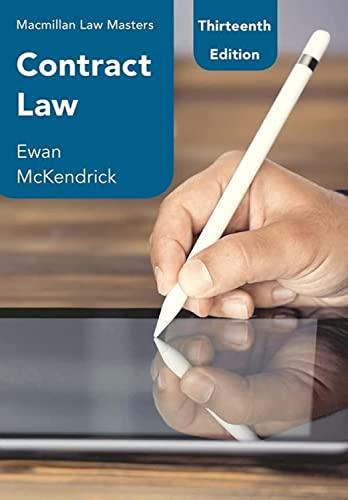Question
A. Bourjois & Co. v. Katzel BACKGROUND AND FACTS A French cosmetic company with a business in the United States sold that business to a
A. Bourjois & Co. v. Katzel
BACKGROUND AND FACTS
A French cosmetic company with a business in the United States sold that business to a U.S. company, A. Bourjois & Co., along with its trademark for face powder. A. Bourjois registered the trademark and continued with the face powder business, using the same box and trademark for the product. Katzel bought a quantity of the same powder in France and sold it in the United States in boxes closely resembling the A. Bourjois boxes, but with its own labels. The plaintiff, A. Bourjois, sued for copyright infringement. It sought a preliminary injunction restraining the defendant from infringing its copyrights.
GUSTICE HOLMES
In 1913 A. Bourjois & Cie., E. Wertheimer & Cie., Successors, doing business in Franceand alsoin the United States, sold the plaintiff for a large sum their business in the United States, with their good will and theirtrade marksregistered in the Patent Office. The latter related particularly to facepowder, andincluded the above words. The plaintiff since its purchase has registered them again and goes on with the business that it bought, using substantially the same form of box and label as its predecessors and importing its face powder from France. It uses care in selecting colorssuitable for the American market, in packing and in keeping up the standard, and has spent much money in advertising, so that the business has grown very great and the labels have come to be understood by the public here as meaning goods coming from the plaintiff. The boxes have upon their backs: "Trade MarksReg. U.S. Pat. Off. Made in FrancePacked in the U.S.A. by A. Bourjois & Co., Inc., of New York,Succ'rs. in the U.S. of A. Bourjois & Cie., and E. Wertheimer & Cie." The defendant, finding that the rate of exchange enabled her to do so at a profit, bought a large quantity of the same powder in France and is selling it here in the French boxes which closely resemble those used by the plaintiff except that they have not the last quoted statement on the backs, and that the label reads, "Poudre de Riz de Java," whereas the plaintiff has found it advisable to strike out the suggestion of rice powder and has "Poudre Java" instead. There is no question that the defendant infringes the plaintiff's rights unless the fact that her boxes and powder are the genuine product of the French concern gives her a right to sell them in the present form. After the sale the French manufacturers could not have come to the United States and have used theirold marks in competition with the plaintiff... .If for the purpose of evading the effect of the transfer, it has arranged with the defendant that she should sell with the old label, we suppose that no one would doubt that the contrivance must fail. There is no such conspiracy here, but, apart from the opening of a door to one, the vendors could not convey their goods free from the restriction to which the vendors were subject... .It deals with a delicate matter that may be of great value but that easily is destroyed, and therefore should be protected with corresponding care. It is said that the trademark here is that of the French house and truly indicates the origin of the goods. But that is not accurate. It is the trademark of the plaintiff only in the United States and indicates in law, and, it is found, by public understanding, that the goods come from the plaintiff although not made by it. It was sold and could only be sold with the good will of the business that the plaintiff bought. It takesthe reputation of the plaintiff upon the character of the goods
Decision. The U.S. Supreme Court reversed the decision of the U.S. Court of Appeals not to grant the plaintiff, A. Bourjois, a preliminary injunction.
K-mart Corp. v. Cartier, Inc
In situations with relatively little possibility of confusion, in which the quality of the gray market product is indistinguishable from the domestic product, U.S. courts have not been solicitous of the rights of licensors. In such cases, courts prize the benefits of price competition over concerns about a free ride for the gray marketer. More recent Supreme Court cases confirm this trend, favoring gray market forces where there is little chance of confusion. In K Mart Corp. v. Cartier, Inc., 486 U.S. 281 (1988), the U.S. Supreme Court allowed the entry of gray market imports as long as the foreign manufacturer and the domestic trademark owner were subject to common control.In K Mart Corp. v. Cartier, Inc., 486 U.S. 281 (1988), the U.S. Supreme Court allowed the entry of gray market importsas long asthe foreign manufacturer and the domestic trademark owner were subject to common control.
question ]InA. Bourjois & Co. v. Katzel, the U.S. Supreme Court determined that the actions of the defendant as an importer of cosmetics from a common French source violated the plaintiff's trademark. InK-mart Corp. v. Cartier, Inc., the U.S. Supreme Court held that a foreign importer would not violate an American trademark owner if both the owner and the foreign importer were subject to common ownership or control.
1]How are these cases compatible?Please ensure you look at the facts of the case and the legal reasoning and that you understand HOW the facts relate to the legal principles.
Step by Step Solution
There are 3 Steps involved in it
Step: 1

Get Instant Access to Expert-Tailored Solutions
See step-by-step solutions with expert insights and AI powered tools for academic success
Step: 2

Step: 3

Ace Your Homework with AI
Get the answers you need in no time with our AI-driven, step-by-step assistance
Get Started


